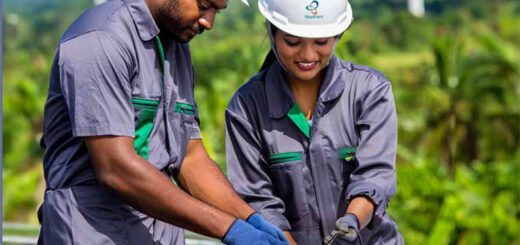For DFCC Bank, prudent balance asset management leads to robust bottom line growth.

In comparison to the previous period’s PBT of Rs. 8,305 million and PAT of Rs. 5,498 million, DFCC Bank PLC reported a Profit Before Tax (PBT) of Rs. 9,559 million and a Profit After Tax (PAT) of Rs. 6,013 million for the period ending September 30, 2024.
Compared to Rs. 8,681 million and Rs. 7,064 million, respectively, in 2023, the Group’s PBT and PAT for the period ending September 30, 2024, were Rs. 9,909 million and Rs. 7,128 million, respectively. The bank’s Return on Equity (ROE) increased from 12.19 percent for the year ending December 31, 2023, to 10.82 percent for the period ending September 30, 2024.
Compared to 1.82 percent for the year ending December 31, 2023, the bank’s Return on Assets (ROA) before taxes for the year ending September 30, 2024, was 1.86 percent. Value Added Tax (VAT), Social Security Contribution Levy (SSCL) on financial services, and income tax are all included in the bank’s total tax charge of Rs. 6,550 million for the fiscal year that ends on September 30, 2024. Consequently, the bank’s tax expense for the period was 52.14 percent of operating earnings.
In order to increase credit to the private sector, the bank has persisted in lowering lending and deposit rates to conform to the Central Bank of Sri Lanka’s present lenient monetary policy stance.
This expansion is likely to continue to be supported by lower market lending interest rates and the predicted recovery in domestic economic activity, which will assist the economy’s anticipated recovery. Compared to the same period in 2023, the lower interest rates have led to decreased interest income and expenses.
By the end of September 2024, the bank’s primary business, Net Interest Income (NII), had dropped by 12% to Rs. 20,734 million.By September 2024, the interest margin had dropped from 5.18 percent in December 2023 to 4.20 percent.
By investing in longer-term, fixed-rate instruments from the start of the year, the bank was able to partially protect its Net Interest Income (NII) despite the steep decline in lending rates.
“Compared to the comparable period of 2023, the bank’s staff’s tireless efforts resulted in an increase in credit card-related operations, which primarily contributed to an increase in fee and commission income,” the DFCC stated.
In keeping with the goal of growing credit card operations and acquiring additional companies, credit card fee charges also went up. The net fee and commission income for the period ending September 30, 2024, increased by 8% to Rs. 3,068 million from Rs. 2,848 million for the same period in 2023, demonstrating a positive net effect as a result of growing the credit card business.
The Bank made a gain of Rs. 2,383 million by selling some of its Sri Lankan government securities that were classed under FVOCI, demonstrating the effectiveness of its strategic choices. On the other hand, the bank lost Rs. 2,172 million when it sold a portion of its International Sovereign Bond (ISB) holdings. The reversal of the impairment provision of Rs. 2,453 million on the sale of ISB, however, counterbalanced this and had a favorable effect on the period’s overall income statement.
Due to substantial portfolio expansion in line with favorable macroeconomic developments and the bank’s coordinated recovery efforts, the impaired loan (stage 3) ratio dropped from 7.03 percent in December 2023 to 6.01 percent as of September 30, 2024.
The bank continued to calibrate internal models to account for future unseen risk factors, including additional provisions made for the bank’s exposure to risk-elevated sectors, in order to make adequate impairment provisions during the period to address the current and potential future impact of the current economic conditions on the lending portfolio.
As a result, the impairment charges for loans and advances improved dramatically to Rs. 3,577 million for the period ending September 30, 2024, from Rs. 11,525 million in the same period, demonstrating favorable macroeconomic indicators and the bank’s coordinated efforts on recovery.
Due mainly to the adjustment for staff benefits and the rise in inflation, operating expenses for the year ending September 30, 2024, increased to Rs. 10,848 million from Rs. 8,370 million during the same period in 2023. Nonetheless, the Bank has implemented a number of cost-cutting strategies, which have led to the management of operational expenses at these levels.
Other comprehensive income is used to document changes in the fair value of investments in fixed-income securities (such as Treasury bills and bonds) and equities securities, as well as shifts in hedging reserves. The impact of exchange rate fluctuations on the bank’s total equity was reduced as a result of the use of hedge accounting.
As of September 30, 2024, equity securities had a net fair value gain of Rs. 1,797 million. The primary driver of the reported fair value gain in equity securities throughout the period was the rise in the share price of Commercial Bank of Ceylon PLC. A fair value gain of Rs. 944 million was also the outcome of the favorable movement in bond yields and Treasury bills.
The DFCC Bank’s total assets increased by Rs. 35 billion, recording a growth of 6 percent from December 2023. In line with the bank’s growth strategy and the current economy, an increase in investment in fixed-income securities has contributed to a 50 percent increase in investment in financial assets at an amortized cost of Rs. 102 billion as at 30 September 2024, compared to the balance as of 31 December 2023. Further, the bank’s net loan portfolio growth of Rs. 34 billion to Rs. 383 billion compared to Rs. 349 billion as at 31 December 2023, an increase of 10 percent, contributed to the asset growth during the period. Moreover, the bank has designated its joint venture investment as an asset held for sale in light of its strategic decision to seek avenues to divest its 50 percent ownership in Acuity Partners Private Limited.
The overall liabilities of the DFCC Bank rose by Rs. 30 billion, representing a 5% rise from December 2023. This is primarily because the Bank’s deposit base increased by 8% during that time, rising from Rs. 407 billion as of December 31, 2023, to Rs. 440 billion, a rise of Rs. 33 billion.
Additionally, as of September 30, 2024, the CASA ratio was 25.82 percent. Medium- to long-term concessionary credit lines are part of the bank’s funding costs; they are mostly utilized to expand the lending portfolio and give our clients much-needed concessionary funding. As of 30 September 2024, the loans-to-deposit ratio increased to 82.30 percent and the CASA ratio improved to 33.33 percent in light of these concessionary term borrowings.
Supported by favorable movements in the equity and fixed income security portfolios classified as fair value through other comprehensive income, positive movements in the hedging reserve, and the reported profit after tax of Rs. 6 billion, DFCC Bank’s total equity increased to Rs. 73.3 billion as of September 30, 2024.
As a result, by September 30, 2024, Tier 1 and Total Capital ratios were 10.708 and 14.358 percent, respectively, up from 11.490 and 13.511 percent as of December 31, 2023. As of 30 September 2024, the bank’s all-currency Liquidity Coverage Ratio (LCR) was 271.46 percent and its Net Stable Funding Ratio (NSFR) was 121.54 percent, down from 597.47 percent and 124.60 percent as of 31 December 2023. As a result, all of these ratios were kept substantially beyond the bare minimum required by law.



Recent Comments